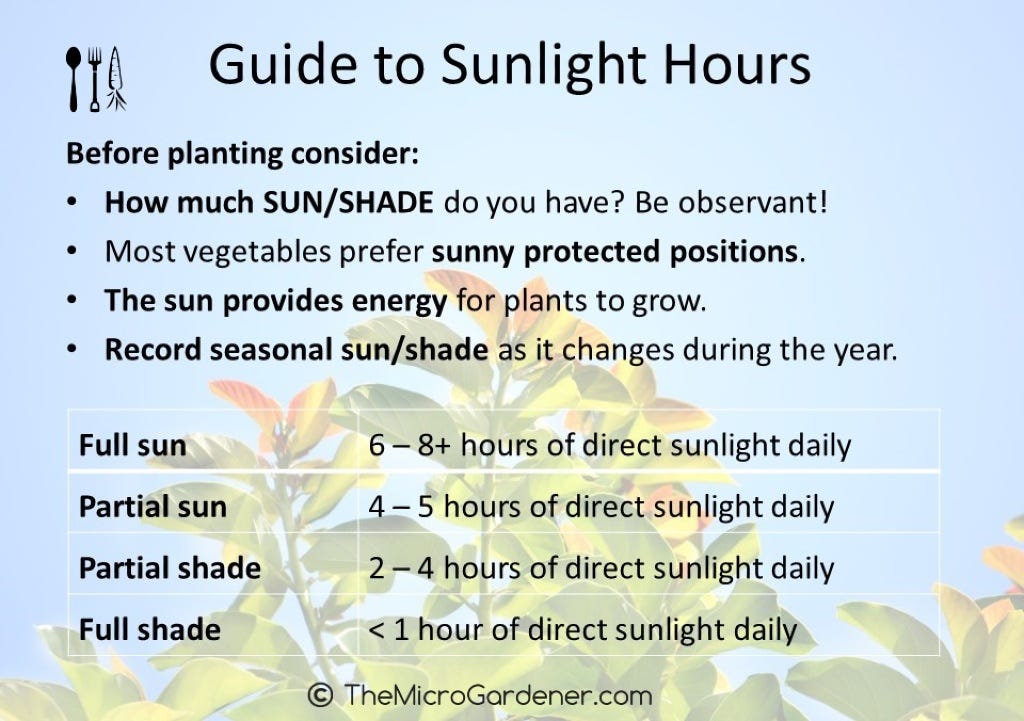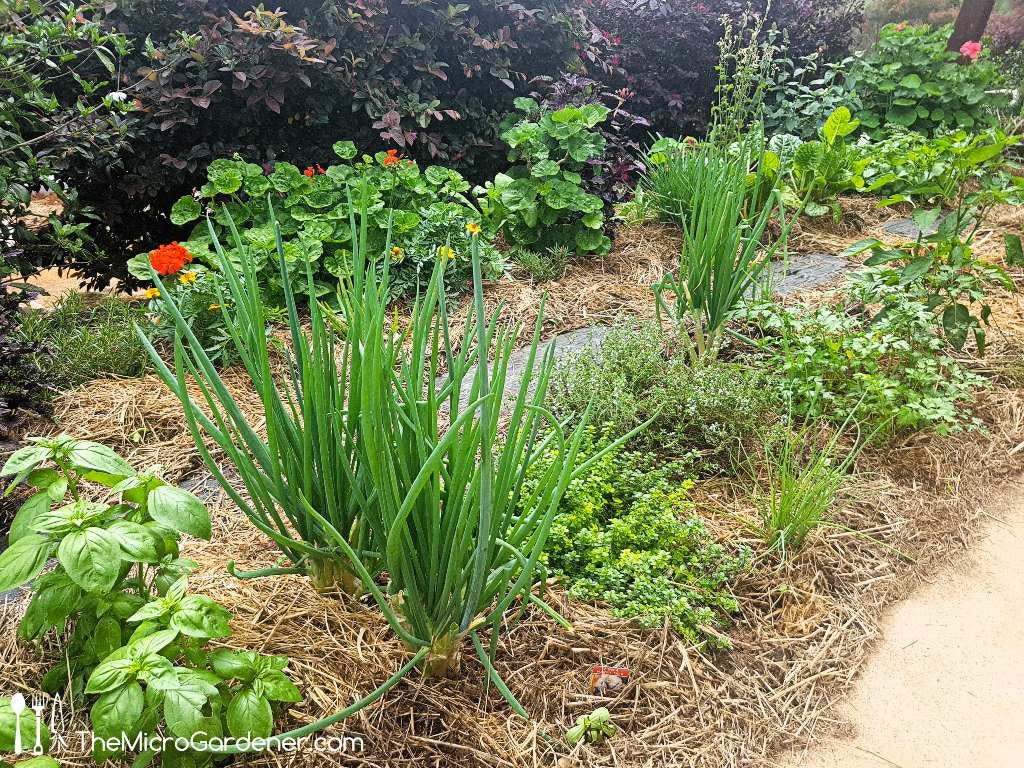The Small Edible Garden Guide: Part 2
Sun, Shade & Soil: How to Read Your Garden’s Clues (Assessing your site, light, wind, microclimates, and drainage)
Welcome to Part 2 of The Small Edible Garden Guide - your step-by-step companion for growing good health in urban spaces. In Part 1: Patch from Scratch - A Small Garden Makeover That Grew Big Things, we laid the groundwork for the early stages of planning: setting priorities, creating a wish list, and drawing inspiration from Shannon’s garden makeover.
📝👀 Now, it’s time to grab your notebook and play garden ‘detective’.
I’ll help you observe your space with intention and tune into your garden’s natural patterns. Tracking sunlight, spotting microclimates, and picking up on the small, sometimes hidden clues nature leaves behind. Why bother? To save time, money and effort by knowing what you’re working with before you plant.
🔎 Let’s take the guesswork out of it to see your garden through a new ‘lens’ so you can design with nature, not against it. Your plants will thank you!
📝Step 3: Assess Your Space and Record Observations
🌳 Every garden is unique. Whether you have a front and backyard, side paths, a balcony, a courtyard or just a few raised beds, each space has distinctive microclimates. That’s why we treat each growing area as a ‘zone’ with its own little ecosystem. 🏡
Directly across the road, my neighbour Tina faces southeast and wakes to the sunrise, but in summer, the morning heat is brutal. So her gardening window is short. Her young trees stand exposed to storms and easterly winds. Mass destruction caused her to redesign her garden and mitigate future damage after nature’s hard lesson.
“It’s been windy today, hasn’t it?” she often says. Yet in my garden, it’s been calm and protected - or the opposite! Just a few metres away, we’re sheltered from the morning sun, allowing me time to tend my plants for longer. But we don’t escape nature’s wrath! Instead, we face scorching westerly heat and drying afternoon winds. We live so close, yet our growing conditions couldn’t be more different!
No site is perfect. Work with what you have and make the best of it.
🌿 Your job now is to slow down, tune in, and read the room - nature’s version.
Start by walking your space. Pause. Watch. Listen.
Begin jotting things down. You’re looking for patterns, not perfection.
Sunlight and Shade: Crack the Light Code ☀️🌿
Light is an often-overlooked but powerful tool to transform your garden’s design. Here’s how to decipher it:
🌄 Track the sun: Observe how light moves within your garden through the day, and across seasons. Morning sunlight is usually cooler and gentler. Afternoon sun is often hot and more intense. Take photos from sunrise to sunset to recheck each season as the sun's angle shifts.
🏡 Layered light: Notice how fences, hedges, trees, buildings, and plants impact zones with dappled sun, deep shade, or full sunlight exposure.
🍂 Clues from plants: Are they stretching toward the sun or getting scorched? These are cries for help - “Move me, mama!”
🌤️ Sunlight basics:
While we’re discussing sunlight, let’s peek back over the fence into Shannon’s front garden from Part 1 of this series. This full sun zone was the best location to grow the maximum number of fruit trees, vegetables, herbs and flowering species. In the before photos, you can see long fingers of sunlight even in late afternoon.
Let’s look at her garden makeover with the second raised bed completed and planted out a couple of months later, which took full advantage of this sunny location. Certainly something to celebrate. I hope it inspires you, too.
NEXT STEP: Map your garden. Sketch your observations.

🧭 Aspect: Which Way Does Your Garden Face?
Southern Hemisphere: Optimum sun comes from the north or north-east.
Northern Hemisphere: Look for south or west-facing spaces.
💡 Even if you don’t have ideal sun, don’t despair. Vertical gardening or pot rotation can help you chase the light. Need ideas for shady spots? Check out:
📋 Your Site Checklist
Before you plan anything permanent, ask yourself:
✅ Time: How much can I honestly give each week?
✅ Labour: Will it be just me, or a shared garden? Who can lend a hand?
✅ Aesthetics: Do I want a formal, wild, minimalist, colourful, neat or rustic look?
✅ Neighbours: Who could I collaborate with? Shared walls/fences/spaces?
✅ Limitations: Mobility, work, children, health, access, travel, budget or HOA?
✅ Water access: Hose nearby? Irrigation? Rainwater collection?
✅ Pets or wildlife: Do I want to accommodate or create habitat? Or deter animals?
✅ Access: Where will I store tools, soil, supplies, worm farm or compost?
📓 Start a “Garden Observations” page in your notebook or phone. If you’re new to the area, your local climate may be a bit of a mystery. Chat with neighbours to uncover past weather patterns or pest issues. Their insights will provide clues to potential challenges and set you up for success.
🍃💨 Wind: Catch the Invisible Clues
Wind can be your friend or foe. Light breezes improve airflow and can help reduce fungal diseases. But strong gusts can impact moisture levels, drying out the soil, stressing the leaves, and making your plants extra thirsty. Stressed plants are also pest magnets.
🌬️ These are good reasons to put on your wind ‘detective hat’:
🧭 Watch leaves flutter: Which way do they blow most often? Their direction hints at prevailing winds. For example, my large banana leaves get shredded if they’re exposed to strong westerlies. This reduces their ability to photosynthesise and slows fruit production.
💨 Feel it: Sit outside on a blustery day. How does it feel? Could you garden comfortably, or need to seek shelter? How are your plants coping?
🌀 Spot the tunnels: Areas between buildings and fences often funnel wind like a blow dryer on steroids. My cherished plants dried out and suffered moisture loss in my last garden until I installed a wind break.
🧱 Identify buffers: Hedges, walls, and fences may create cooler, sheltered spots ideal for tender crops. They may also cast unwanted shade that can cause a lawn to struggle. In my Pharmacy Herb Garden below, a wind-buffering hedge protects my plants from storms and provides shade relief from summer heat.
Microclimates: Discover the Hidden Nooks 🔍
Your garden has microclimates - little pocket zones with different temperatures, light, soil moisture, and wind conditions. What to look for:
Warm zones: Sunny brick or stone walls store heat and radiate it gradually. Dark coloured pavers absorb more heat than lighter surfaces and can provide warmth to nearby plants. Sun-exposed concrete retains warmth well. Water features also hold heat, helping moderate temperature fluctuations. I use black pots for our basil during cooler months to extend the harvest. Reflective surfaces like glass or metal fences can direct sunlight onto plants, but may also cause overheating.
Cool zones: Shaded, breezy areas might suit leafy greens in summer.
Moisture clues: Moss or lichen? A hint at damp soil. Boggy? Poorly draining. These spots might get water run-off, have clay soil, be near a downpipe or an air conditioner drip outlet. Dry, cracked soil? Look for drought-tolerant plants nearby.
Fog or frost pockets: Low areas often stay cooler. Watch for lingering dew or frost. These are vulnerable areas where plants may need protection.
In this video, I walk you around the microclimates in my kitchen garden raised beds.
TIP: Walk through your garden and ask yourself, “Am I comfortable here?” If you’d avoid an area in the heat of summer, chances are your plants would too.
Soil, Drainage and What Lies Beneath
Soil type and drainage speak volumes about what will thrive - and what needs help.
Get your hands dirty:
✋🏼 Feel your soil: Is it gritty (sandy), smooth (silty or loamy), or sticky (clay)?
⌚ Test drainage: Dig a small hole, fill it with water, and see how long it takes to drain.
💧 Watch water movement: Does it puddle? Flow? Disappear in seconds?
Heavy clay may need compost or raised beds. Sandy soils may benefit from mulch and water-holding amendments. Knowing this early helps you avoid planting in a spot that’s challenging from the start.
📝 The Importance of Keeping Notes
Your garden is dynamic. Take notes each season - sun hours, wind direction, frost, dry patches. These breadcrumbs help you adapt, troubleshoot, and make informed decisions. Once you know the unique conditions you’re working with, you can design with nature rather than against it for greater success.
🎯 Reality Check: Start Where You Are
You don’t need a perfect space. You need a curious mindset, time and patience, and a willingness to experiment. Tiny spaces can yield abundant harvests if you observe, plan, and grow with intention.
Start small. Add elements that bring you JOY. Your garden should work for you, not the other way around!
🌿 Up next in The Small Edible Garden Guide…
In Part 3, we’ll get practical about what to grow and why - based on your lifestyle, time, taste buds, and space. Whether you’re feeding a family or just want fresh herbs on hand, the next article will help you prioritise with purpose and create a garden that feeds your mind, body and soul.🌱 Thanks for reading, Anne
☕ If this piece helped you forage something useful, a coffee helps me keep creating.
AI Notice: This content is not authorised for AI training, scraping, or summarisation. © Anne Gibson, All rights reserved 2025.












